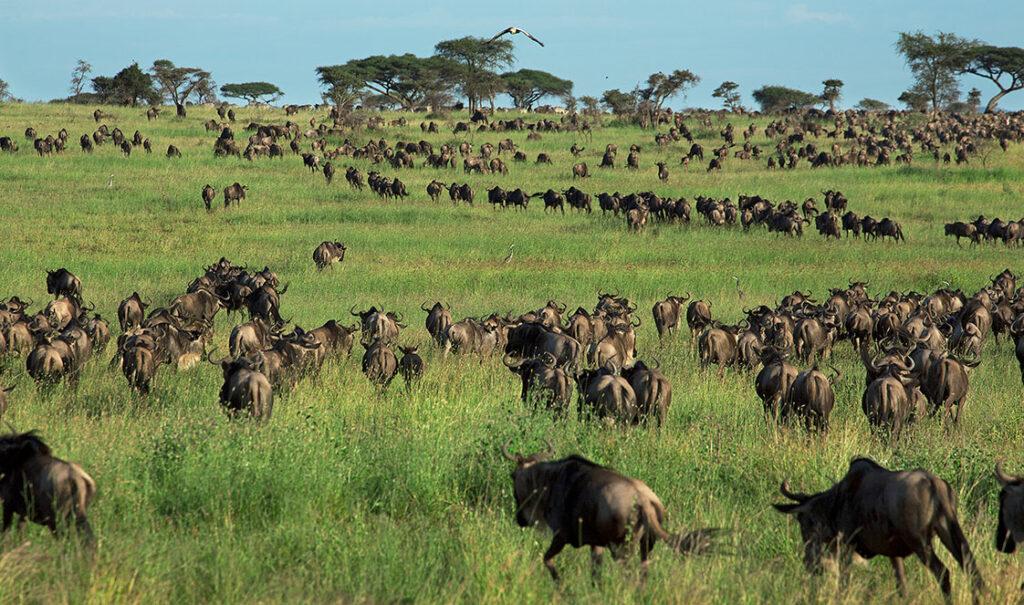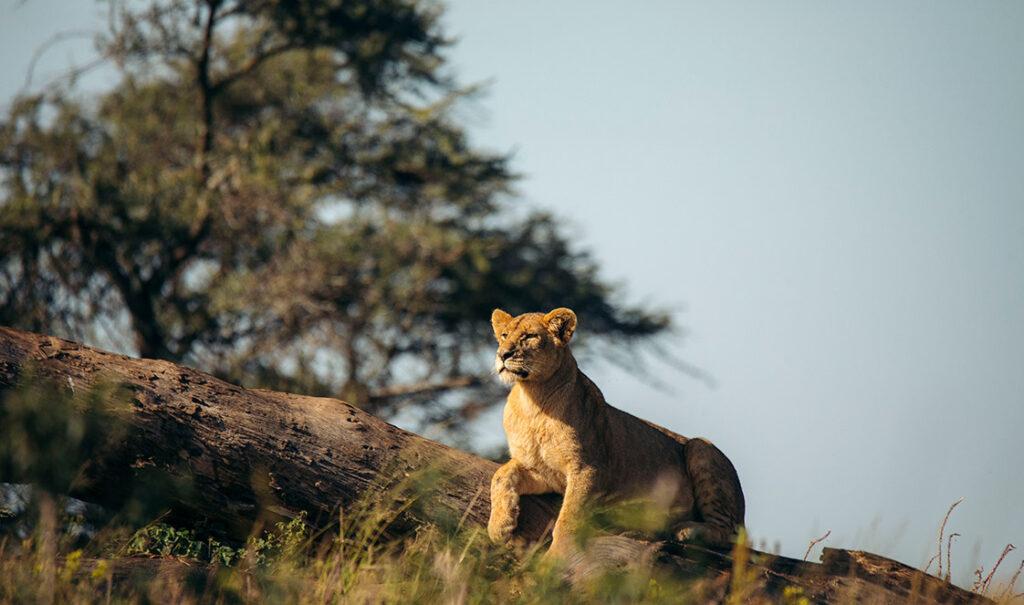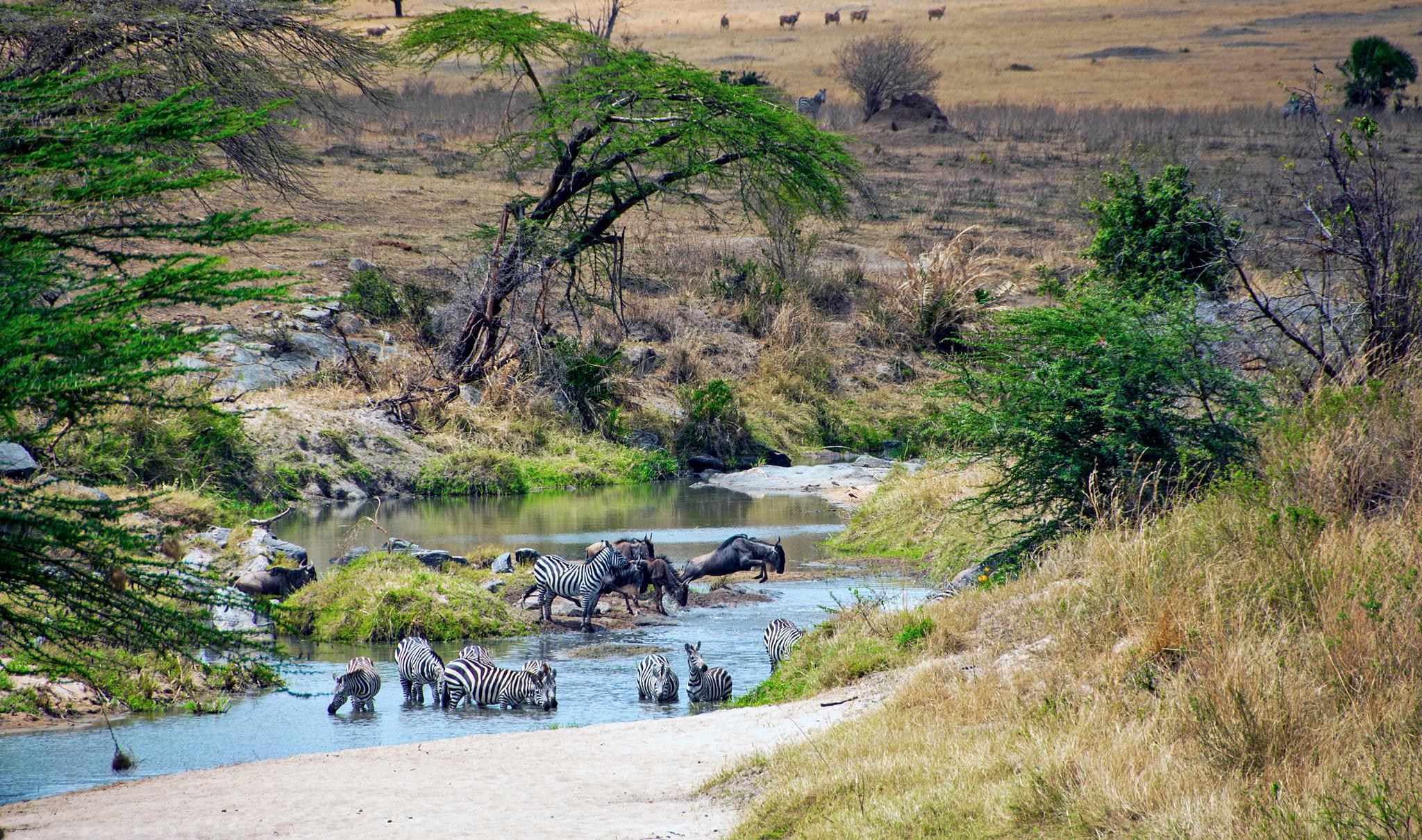January is an excellent month to visit Tanzania as the landscapes come alive after the short rains in November and December. It is the shoulder season, which means fewer visitors, allowing you to experience the magic of Tanzania without the crowds. The weather in Tanzania in January is warm, with only a slight chance of passing afternoon thunderstorms. This makes it an ideal time not only for safaris, but also for diving and snorkelling throughout the Zanzibar archipelago and trekking Africa’s tallest mountain, Mount Kilimanjaro.
Inland, the light and clarity of the air are perfect for photography, with the added possibility of capturing photos of migratory birds. In the savannahs, it is a time of new life as the southern Serengeti becomes a grassland nursery, where huge mega-herds of wildebeest give birth to 500,000 calves in just a few weeks. Tanzania in January is a great travel destination!

What is the weather like in Tanzania in January?
Tanzania has a tropical climate that experiences two rainy and two dry seasons. There is no winter or summer season as you may know it from countries in the northern hemisphere. Therefore, January is the ideal time to revel in Tanzania’s warm and relatively dry weather, escaping the dark winter weather in the northern countries.
January marks the beginning of a two-month dry spell between the short rains (November to December) and the long rains (March to May) in Tanzania. Throughout January, there is a slight chance of rain everywhere, particularly in the afternoon or at night.
It is also one of the months, from November to May, referred to as the “green season” in Tanzania due to the vibrant green growth during this period. Therefore, it is an ideal month for a safari on the Northern Circuit as well as trekking Mount Kilimanjaro and capturing wildlife and landscape photos during a photography safari. If you plan to visit the parks in southern Tanzania, the scenery remains stunning, although the chance of rain is slightly higher.
On the Swahili Coastline, January is one of the hottest months, with the possibility of an afternoon thunderstorm. Still, January is an excellent time for a beach retreat on Zanzibar.

If you stay at altitude, the temperature and rainfall can vary considerably. For instance, if you’re visiting Ngorongoro Conservation Area, a UNESCO World Heritage Site, you’ll stay overnight on the crater’s rim at about 2300m, where temperatures fall dramatically at night, and frost is commonplace.
In conclusion, with its tropical climate, green scenery, and endless opportunities for adventure, January is the perfect time to immerse yourself in the natural beauty of Tanzania.
Average temperature in Tanzania in January
Tanzania has a consistently warm climate. During January, the temperatures on the coast and on Zanzibar climb to 35°C (95°F). Inland, they also rise, reaching up to 29°C (84°F) during the afternoon. High-altitude areas are cooler, ranging from 25°C (77°F) in the day to 13°C (55°F) at night. No matter where you go on safari, early morning game drives can be cold, so pack a warm layer that can be taken off later as the temperature warms up.

Best time for a Tanzania safari
With green landscapes and warm weather, Tanzania is perfect for a January safari and a beach getaway on the Zanzibar archipelago. However, with so many options available on the internet, it can be overwhelming to decide where to go. Don’t worry we are here to help.
By far, the easiest method of selecting where to go after some preliminary research is to talk to one of our travel experts for a no-obligation conversation; they are Tanzania experts and will be very happy to share their passion for Tanzania with you. Within a short conversation, you will receive all the information you need. Or you can read on for more information on where to go in Tanzania in January.
January is the perfect time for a Northern Circuit safari for several reasons. Firstly, the north of Tanzania receives less rainfall than the south this month, making it a practical choice. Secondly, you can avoid the crowds that visit the popular northern national parks during peak season, from June to October. Thirdly, an extraordinary natural wonder occurs in northwest Tanzania in January that will leave a lasting impression – the wildebeest calving season.

Every year, 1.5 million wildebeest embark on a 1000 km journey through the Serengeti National Park and Kenya’s Masai Mara National Reserve in search of fresh grass, which is known as the Great Wildebeest Migration. The yearly cycle has several fascinating stages, including the rut in May, the river-crossings from late June to July and the calving season from January to February.
Why is the calving season so special? It is an extraordinary event in the natural world. After the short rains, the wildebeest migrate south from Kenya’s Masai Mara National Reserve and gather in huge mega-herds on the short-grass plains of the southern Serengeti National Park and Ngorongoro Conservation Area. The Ndutu and Kusini plains are hot spots for these mega-herds.
It’s a magnificent sight to witness. The green plains transform into a birthing ground for thousands of animals that dot the landscape. The mineral-rich grasses, nourished by fertile volcanic soils, are the perfect spot to give birth, with around 500,000 calves born in just a few weeks.
Inevitably, large herds combined with weak day-old calves attract a large concentration of big cats. As a result, visitors will witness the delicate balance between life and death during the countless stories that unfold on the plains. Seeing the calving season will be an unforgettable experience.
Two of our favourite safaris in Tanzania in January:

Big Migration
Places Tarangire National Park, Serengeti National Park, Ngorongoro Crater
from 2,610 USD (based on 7 persons)

Best of Tanzania
Places Tarangire National Park, Serengeti National Park, Karatu, Ngorongoro Crater
from 2,840 USD per person sharing
Locational highlights to see and do in Tanzania in January:
- January at the coast can be hot with rising humidity levels, but it’s an excellent time for scuba diving with visibility up to 30m.
- This a good month for trekking Mount Kilimanjaro or Mount Meru.
- It is a beautiful period for a balloon safari in the Serengeti and Tarangire National Parks.

What is the cost of visiting Tanzania in January
January is considered the shoulder season in Tanzania, making it slightly cheaper than the high season. As prices tend to go up in February, you might be able to save a little money in January. However, it’s important to note that you won’t make significant savings since national park fees remain the same, and most property prices won’t vary greatly. The main advantage of visiting Tanzania in January is that it is a great time to see the wildlife, the landscapes are green with fewer visitors, and it is an ideal time to witness the wildebeest calving season.
What to wear in Tanzania in January
January is one of the warmest months in Tanzania, making it the perfect time to visit. Here are some guidelines to help you pack.
- In general, it’s best to wear soft, light-coloured clothing with long sleeves and trousers to protect yourself from the sun and biting insects.
- Pack warm clothing for early morning game drives and avoid wearing camouflage or bright colours, including dark blue and black. Bring a small rucksack to carry guide books, water, binoculars and sun protection such as hats and sunglasses.
- If you want to wear flip-flops, bring closed shoes for game drives and sitting around the campfire at night.
- Prepare for staying at a lodge by bringing your swimsuit to take a refreshing swim in the pool during hot afternoons. Break out something smart to wear to enjoy a classic safari dinner in the evening.
- If you plan to visit Zanzibar, please dress modestly by covering your shoulders and knees in public places.
We are happy to assist you in planning your trip to Tanzania – in January or any other month of the year. As local tour operator based close to Arusha, we are on site and right where you need us. Get in touch and let’s start planning today!
 on Tripadvisor
on Tripadvisor




